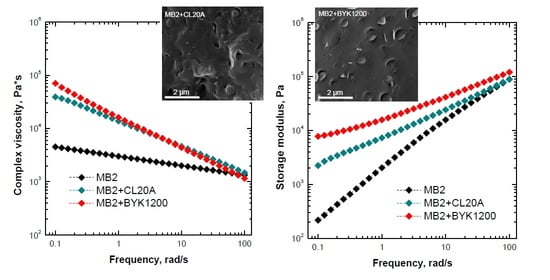Bionanocomposite Blown Films: Insights on the Rheological and Mechanical Behavior
Abstract
:1. Introduction
2. Materials and Methods
2.1. Materials
- HF03V0 (hereafter coded as MB1): density = 1.28 g/cm3, Melt Flow Index - MFI (160 °C, 2.16 kg) = 2.5 g/10 min;
- EF51L (hereafter coded as MB2): density = 1.22 g/cm3, MFI (190 °C, 2.16 kg) = 4.5 g/10 min;
2.2. Nanocomposite and Blown Film Preparation
2.3. Characterizations
3. Results and Discussion
3.1. Morphology
3.2. Rheological Behavior
3.3. Mechanical Properties
3.4. Processing Behavior
3.5. Characterization of Blown Films
4. Conclusions
Author Contributions
Funding
Institutional Review Board Statement
Informed Consent Statement
Data Availability Statement
Conflicts of Interest
References
- Alavi, S.; Thomas, S.; Sandeep, K.P.; Kalarikkal, N.; Varghese, J.; Yaragalla, S. Polymers for Packaging Applications; CRC Press: Oakville, ON, Canada, 2014. [Google Scholar]
- Balakrishnan, P.; Thomas, M.S.; Pothen, L.A.; Thomas, S.; Sreekala, M.S. Polymer Films for Packaging. In Encyclopedia of Polymeric Nanomaterials; Kobayashi, S., Müllen, K., Eds.; Springer: Berlin/Heidelberg, Germany, 2014. [Google Scholar]
- Selke, S.E.M.; Culter, J.D. Plastics Packaging—Properties, Processing, Applications, and Regulations, 3rd ed.; Hanser Publishers: München, Germany, 2016. [Google Scholar]
- Tran, T.N.; Mai, B.T.; Setti, C.; Athanassio, A. Transparent Bioplastic Derived from CO2-Based Polymer Functionalized with Oregano Waste Extract toward Active Food Packaging. ACS Appl. Mater. Interfaces 2020, 12, 46667–46677. [Google Scholar] [CrossRef]
- Muthuraj, R.; Misra, M.; Mohanty, A.K. Biodegradable compatibilized polymer blends for packaging applications: A literature review. J. Appl. Polym. Sci. 2018, 135, 45726. [Google Scholar] [CrossRef] [Green Version]
- Wang, K.; Liang, S.; Deng, J.; Yang, H.; Zhang, Q.; Fu, Q.; Dong, X.; Wang, D.; Han, C.C. The role of clay network on macromolecular chain mobility and relaxation in isotactic polypropylene/organoclay nanocomposites. Polymer 2006, 47, 7131–7144. [Google Scholar] [CrossRef]
- Silvestre, C.; Duraccio, D.; Cimmino, S. Food packaging based on polymer nanomaterials. Progr. Polym. Sci. 2011, 36, 1766–1782. [Google Scholar] [CrossRef]
- Fang, H.; Bai, S.L.; Wong, C.P. Thermal, mechanical and dielectric properties of flexible BN foam and BN nanosheets reinforced polymer composites for electronic packaging application. Compos. Part A Sci. Manuf. 2017, 100, 71–80. [Google Scholar] [CrossRef]
- Bai, D.; Liu, H.; Bai, H.; Zhang, Q.; Fu, Q. Low-Temperature Sintering of Stereocomplex-Type Polylactide Nascent Powder: Effect of Crystallinity. Macromolecules 2017, 50, 7611–7619. [Google Scholar] [CrossRef]
- Sangroniz, A.; Zhu, J.B.; Tang, X. Packaging materials with desired mechanical and barrier properties and full chemical recyclability. Nat. Commun. 2019, 10, 1–7. [Google Scholar] [CrossRef] [Green Version]
- Wang, J.; Yu, J.; Bai, D.; Li, Z.; Liu, H.; Li, Y.; Chen, S.; Cheng, J.; Li, L. Biodegradable, Flexible, and Transparent Conducting Silver Nanowires/Polylactide Film with High Performance for Optoelectronic Devices. Polymers 2020, 12, 604. [Google Scholar] [CrossRef] [Green Version]
- Qasim, U.; Osman, A.I.; Al-Muhtaseb, A.H.; Farrell, C.; Al-Abri, M.; Ali, M.; Vo, D.V.N.; Jamil, F.; Rooney, D.W. Renewable cellulosic nanocomposites for food packaging to avoid fossil fuel plastic pollution: A review. Environ. Chem. Lett. 2021, 19, 613–641. [Google Scholar] [CrossRef]
- Luzi, F.; Torre, L.; Kenny, J.M.; Puglia, D. Bio- and Fossil-Based Polymeric Blends and Nanocomposites for Packaging: Structure–Property Relationship. Materials 2019, 12, 471. [Google Scholar] [CrossRef] [Green Version]
- Jamróz, E.; Kulawik, P.; Kopel, P. The Effect of Nanofillers on the Functional Properties of Biopolymer-Based Films: A Review. Polymers 2019, 11, 675. [Google Scholar] [CrossRef] [Green Version]
- Rhim, J.W.; Park, H.M.; Ha, C.S. Bio-nanocomposites for food packaging applications. Progr. Polym. Sci. 2013, 38, 1629–1652. [Google Scholar] [CrossRef]
- Yu, L.; Dean, K.; Li, L. Polymer blends and composites from renewable resources. Progr. Polym. Sci. 2006, 31, 576–602. [Google Scholar] [CrossRef]
- Niranjana Prabhu, T.; Prashantha, K. A review on present status and future challenges of starch based polymer films and their composites in food packaging applications. Polym. Compos. 2018, 39, 2499–2522. [Google Scholar] [CrossRef]
- Calvino, C.; Macke, N.; Kato, R.; Rowan, S.J. Development, processing and applications of bio-sourced cellulose nanocrystal composites. Progr. Polym. Sci. 2020, 103, 101221. [Google Scholar] [CrossRef]
- Liu, D.; Zhang, Y.; Sun, X.; Chang, P.R. Recent advances in bio-sourced polymeric carbohydrate/nanotube composites. J. Appl. Polym. Sci. 2014, 131, 40359. [Google Scholar] [CrossRef]
- De Silva, R.T.; Pasbakhsh, P.; Lee, S.M.; Kit, A.Y. ZnO deposited/encapsulated halloysite–poly (lactic acid) (PLA) nanocomposites for high performance packaging films with improved mechanical and antimicrobial properties. Appl. Clay Sci. 2015, 111, 10–20. [Google Scholar] [CrossRef]
- Gupta, A.; Simmons, W.; Schueneman, G.T.; Hylton, D.; Mintz, E.A. Rheological and thermo-mechanical properties of poly(lactic acid)/lignin-coated cellulose nanocrystal composites. ACS Sustain. Chem. Eng. 2017, 5, 1711–1720. [Google Scholar] [CrossRef]
- Bastioli, C. Properties and applications of Mater-Bi starch-based materials. Polym. Degrad. Stab. 1998, 59, 263–272. [Google Scholar] [CrossRef]
- La Mantia, F.P.; Ceraulo, M.; Mistretta, M.C.; Morreale, M. Rheological Behaviour, Mechanical Properties and Processability of Biodegradable Polymer Systems for Film Blowing. J. Polym. Environ. 2018, 26, 749–755. [Google Scholar] [CrossRef]
- Briassoulis, D.; Giannoulis, A. Evaluation of the functionality of bio-based food packaging films. Polym. Test. 2018, 69, 39–51. [Google Scholar] [CrossRef]
- Ambrogi, V.; Cerruti, P.; Carfagna, C.; Malinconico, M.; Marturano, V.; Perrotti, M.; Persico, P. Natural antioxidants for polypropylene stabilization. Polym. Degrad. Stab. 2011, 96, 2152–2158. [Google Scholar] [CrossRef]
- La Mantia, F.P.; Arrigo, R.; Morreale, M. Effect of the orientation and rheological behaviour of biodegradable polymer nanocomposites. Eur. Polym. J. 2014, 54, 11–17. [Google Scholar] [CrossRef]
- Puglia, D.; Tomassucci, A.; Kenny, J.M. Processing, properties and stability of biodegradable composites based on Mater-Bi® and cellulose fibres. Polym. Adv. Technol. 2003, 14, 749–756. [Google Scholar] [CrossRef]
- Golebiewski, J.; Rozanski, A.; Dzwonkowski, J.; Galeski, A. Low density polyethylene–montmorillonite nanocomposites for film blowing. Eur. Polym. J. 2008, 44, 270–286. [Google Scholar] [CrossRef]
- Scaffaro, R.; Sutera, F.; Botta, L. Biopolymeric bilayer films produced by co-extrusion film blowing. Polym. Test. 2018, 65, 35–43. [Google Scholar] [CrossRef]
- Cunha, M.; Fernandes, B.; Covas, J.A.; Vicente, A.V.; Hilliou, L. Film blowing of PHBV blends and PHBV-based multilayers for the production of biodegradable packages. J. Appl. Polym. Sci. 2016, 133, 42165. [Google Scholar] [CrossRef] [Green Version]
- Al-Itry, R.; Lamnawar, K.; Maazouz, A. Biopolymer Blends Based on Poly (lactic acid): Shear and Elongation Rheology/Structure/Blowing Process Relationships. Polymers 2015, 7, 939–962. [Google Scholar] [CrossRef]
- Lim, T.A.; Auras, R.; Rubino, M. Processing technologies for poly(lactic acid). Progr. Polym. Sci. 2008, 33, 820–852. [Google Scholar] [CrossRef]
- La Mantia, F.P.; Ceraulo, M.; Mistretta, M.C.; Sutera, F.; Ascione, L.; Nasillo, G. Effect of Elongational Flow and Polarity of Organomodified Clay on Morphology and Mechanical Properties of a PLA Based Nanobiocomposite. Int. Polym. Proc. 2016, 31, 541–547. [Google Scholar] [CrossRef]
- Mooninta, S.; Poompradub, S.; Prasassarakich, P. Packaging Film of PP/LDPE/PLA/Clay Composite: Physical, Barrier and Degradable Properties. J. Polym. Environ. 2020, 28, 3116–3128. [Google Scholar] [CrossRef]
- Thellen, C.; Orroth, C.; Froio, D.; Ziegler, D.; Lucciarini, J.; Farrell, R.; D’Souza, N.A.; Ratto, J.A. Influence of montmorillonite layered silicate on plasticized poly(l-lactide) blown films. Polymer 2005, 46, 11716–11727. [Google Scholar] [CrossRef]
- Herrera, N.; Roch, H.; Salaberria, A.M.; Pino-Orellana, M.A.; Labidi, J.; Fernandes, S.C.M.; Radic, D.; Leiva, A.; Oksman, K. Functionalized blown films of plasticized polylactic acid/chitin nanocomposite: Preparation and characterization. Mater. Des. 2016, 92, 846–852. [Google Scholar] [CrossRef]
- Titone, V.; Correnti, A.; La Mantia, F.P. Effect of the Moisture on the Processing and on the Mechanical Properties of a Biodegradable Polymer. Polym. Eng. Sci. 2021. Sent for publication. [Google Scholar]
- Ghanbari, A.; Heuzey, M.C.; Carreau, P.J.; Ton-That, M.T. Morphological and rheological properties of PET/clay nanocomposites. Rheol. Acta 2013, 52, 59–74. [Google Scholar] [CrossRef]
- Ren, J.; Krishnamoorti, R. Nonlinear viscoelastic properties of layered silicate-based intercalated nanocomposites. Macromolecules 2003, 36, 4443–4451. [Google Scholar] [CrossRef]
- Malucelli, G.; Ronchetti, S.; Lak, N.; Priola, A.; Dintcheva, N.T.; La Mantia, F.P. Intercalation effects in LDPE/o-montmorillonites nanocomposites. Eur. Polym. J. 2007, 43, 328–335. [Google Scholar] [CrossRef]
- Lepoittevin, B.; Devalckenaere, M.; Pantoustier, N.; Alexandre, M.; Kubies, D.; Calberg, C.; Jérôme, R.; Dubois, P. Poly(ε-caprolactone)/clay nanocomposites prepared by melt intercalation: Mechanical, thermal and rheological properties. Polymer 2002, 43, 4017–4023. [Google Scholar] [CrossRef]
- He, X.; Yang, J.; Zhu, L.; Wang, B.; Sun, G.; Lv, P.; Phang, I.Y.; Liu, T. Morphology and melt rheology of nylon 11/clay nanocomposites. J. Appl. Polym. Sci. 2006, 102, 542–549. [Google Scholar] [CrossRef] [Green Version]
- Lim, Y.T.; Park, O.O. Phase morphology and rheological behavior of polymer/layered silicate nanocomposites. Rheol. Acta 2001, 40, 220–229. [Google Scholar] [CrossRef]
- Ghijsels, A.; Massardier, C.H.C.; Bradley, R.M. Brittle Melt Rupture Phenomena in Polymer Processing. An Overview. Int. Polym. Proc. 2003, 12, 147–154. [Google Scholar] [CrossRef]
- Gigante, V.; Aliotta, L.; Coltelli, M.B.; Cinelli, P.; Botta, L.; La Mantia, F.P.; Lazzeri, A. Fracture behavior and mechanical, thermal, and rheological properties of biodegradable films extruded by flat die and calender. J. Polym. Sci. 2020, 58, 3264–3282. [Google Scholar] [CrossRef]
- La Mantia, F.P.; Fontana, P.; Morreale, M.; Mistretta, M.C. Orientation induced brittle—Ductile transition in a polyethylene/polyamide 6 blend. Polym. Test. 2014, 36, 20–23. [Google Scholar] [CrossRef]
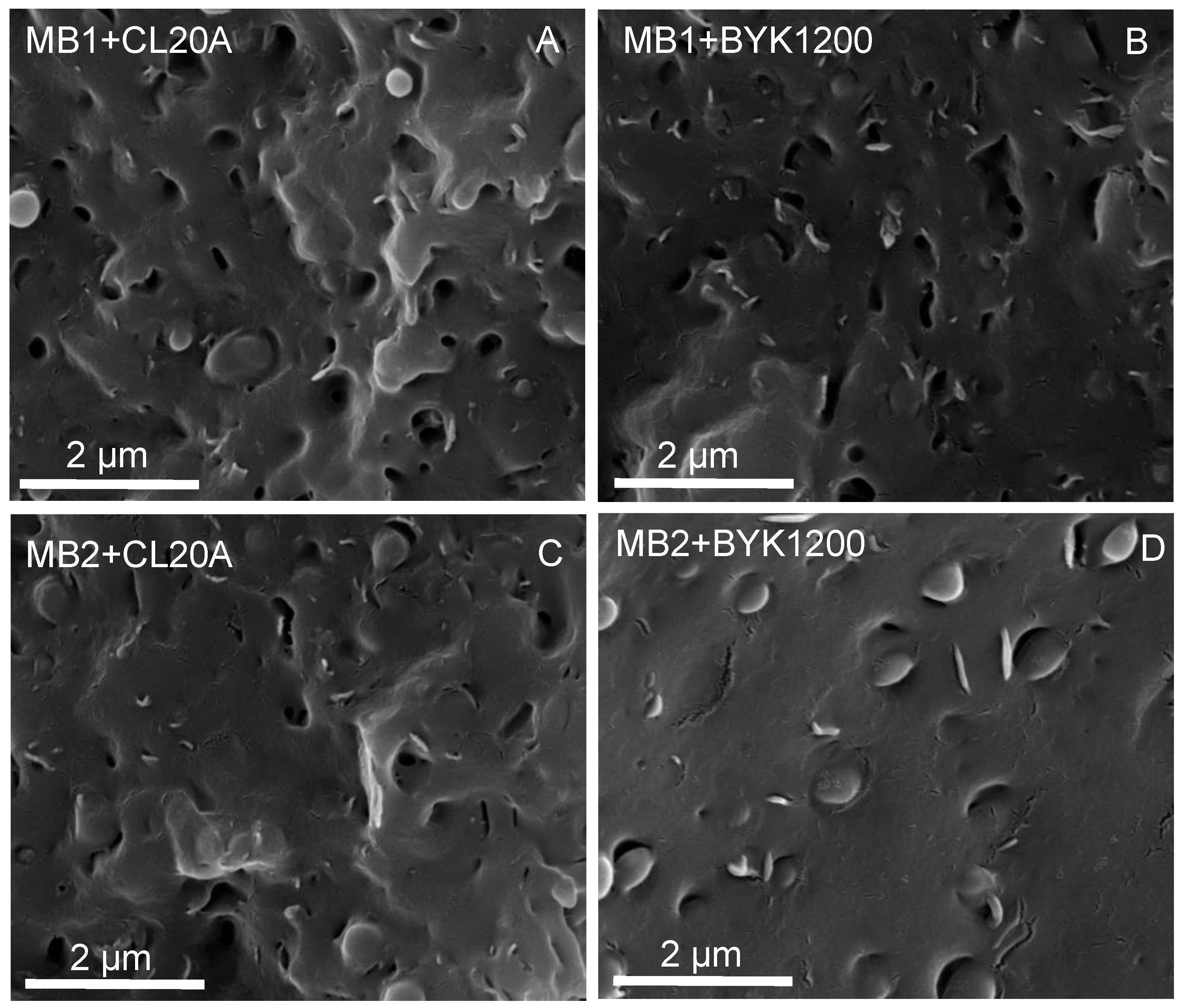
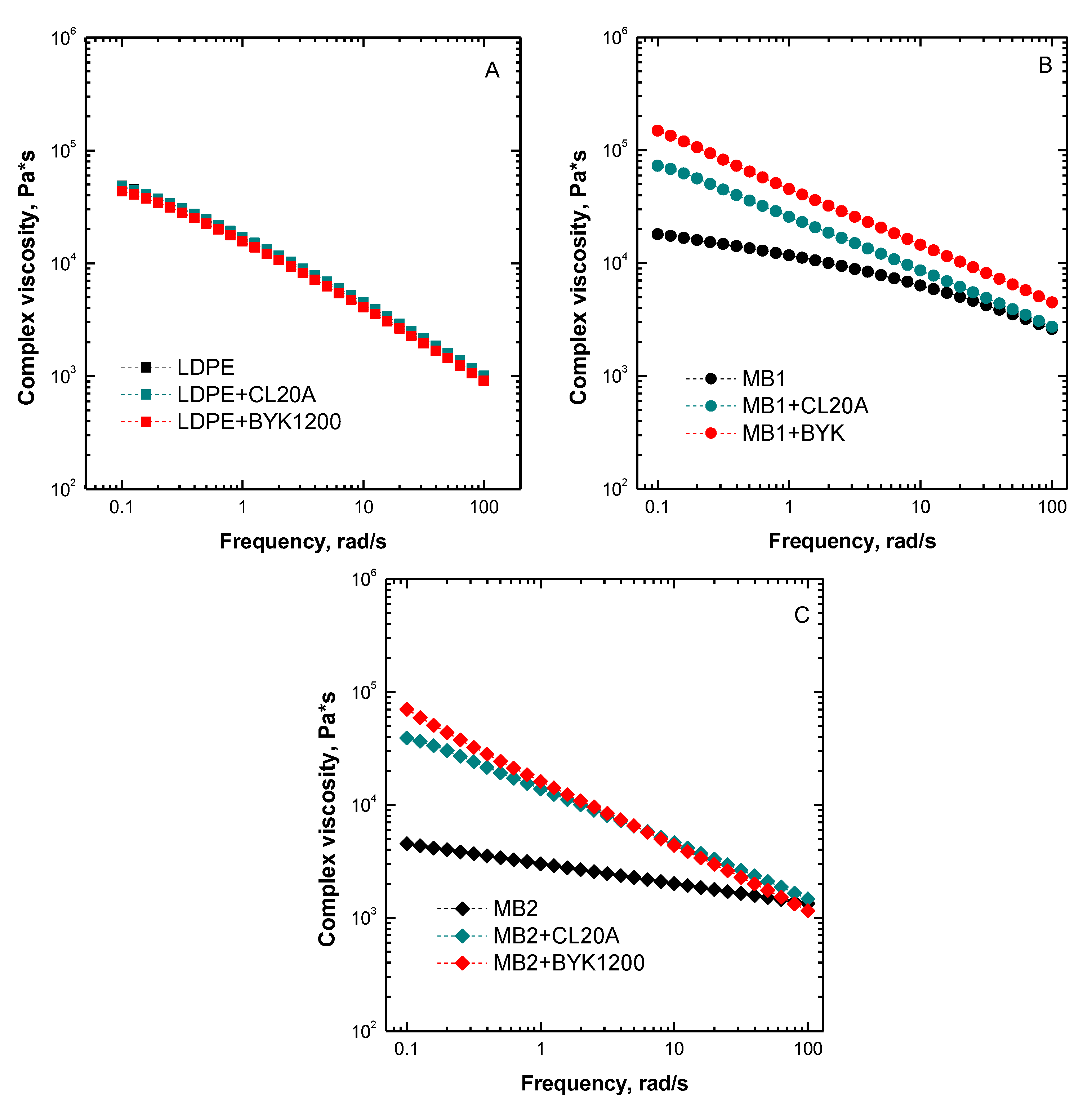
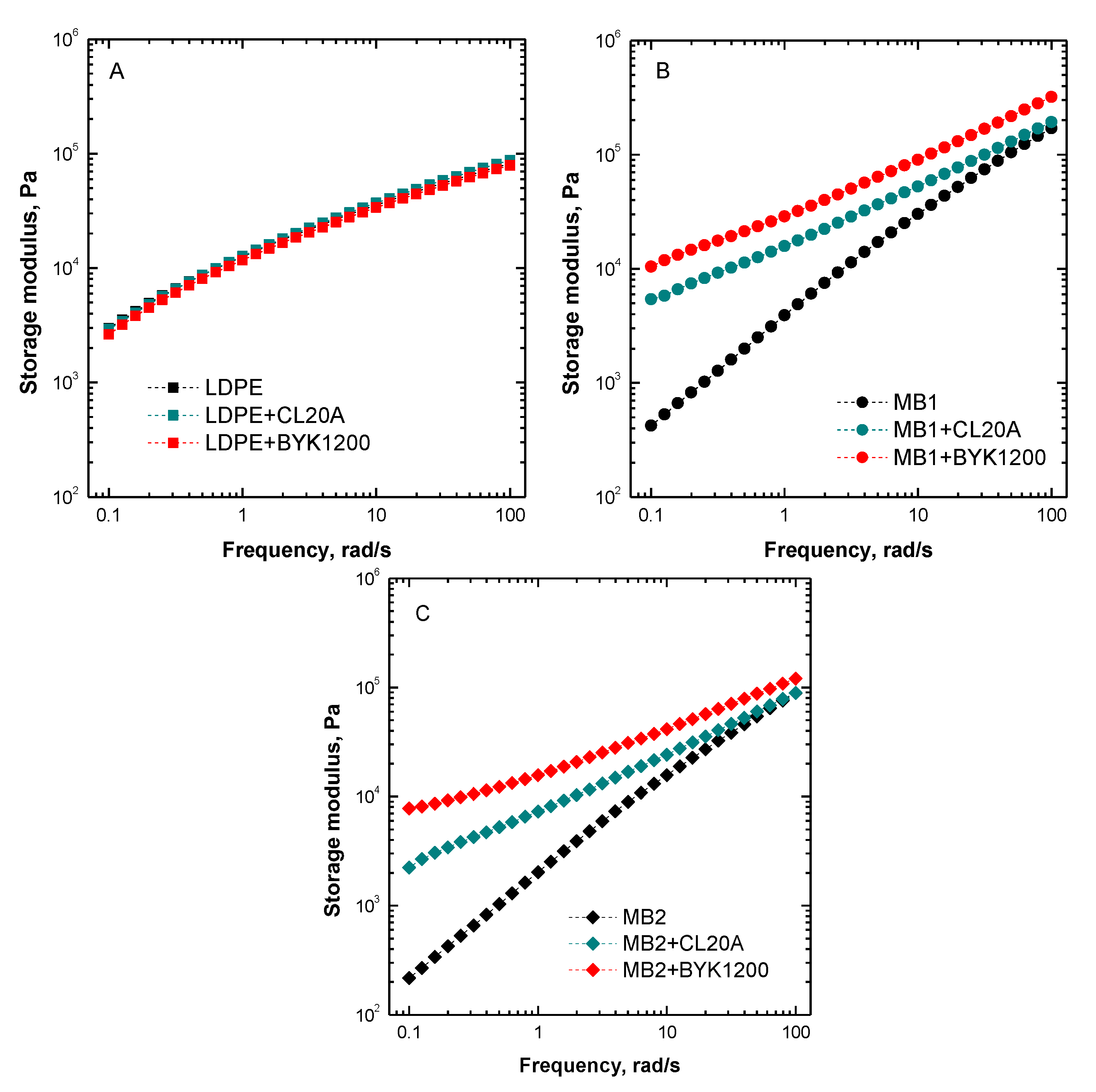
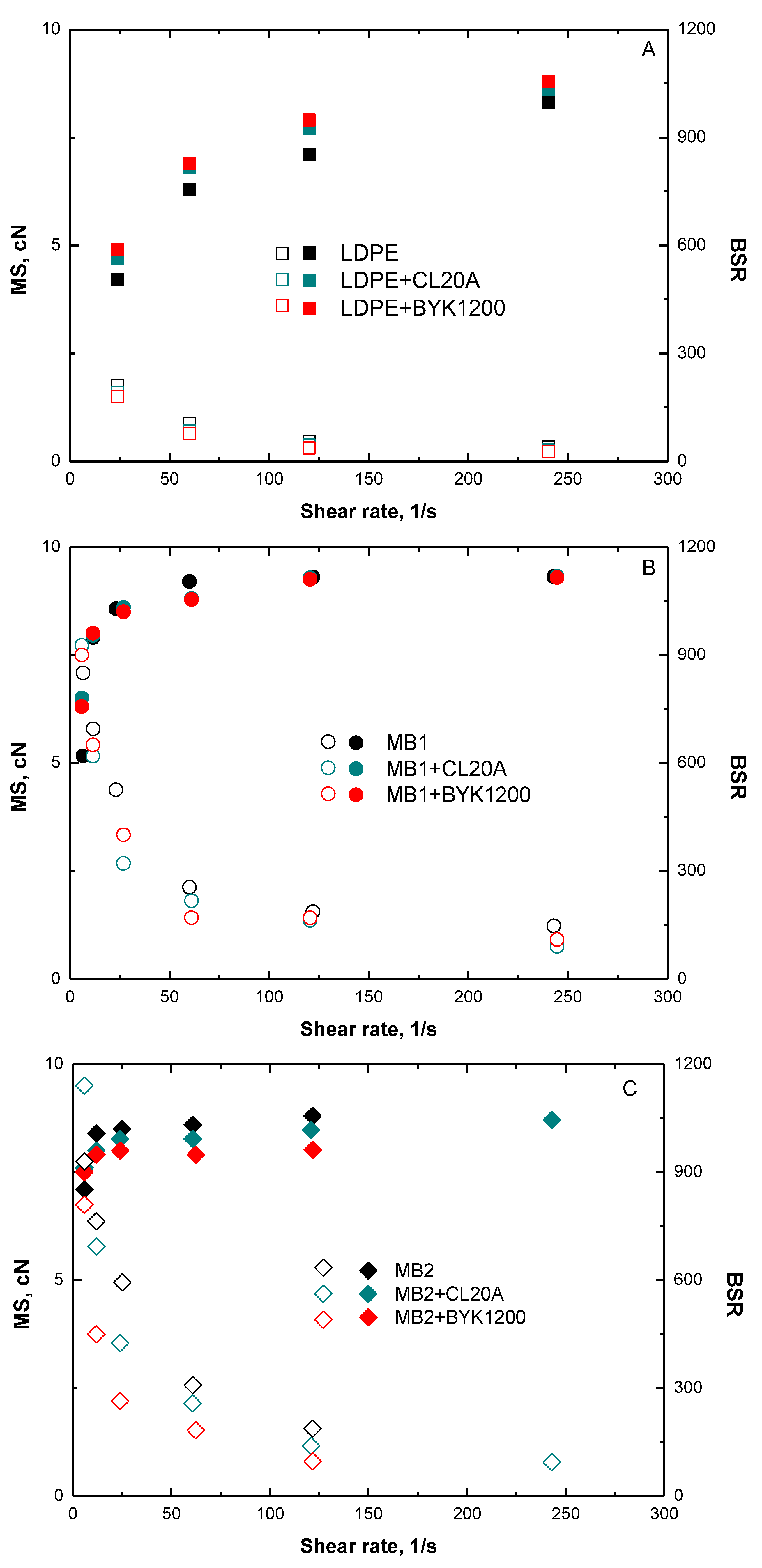
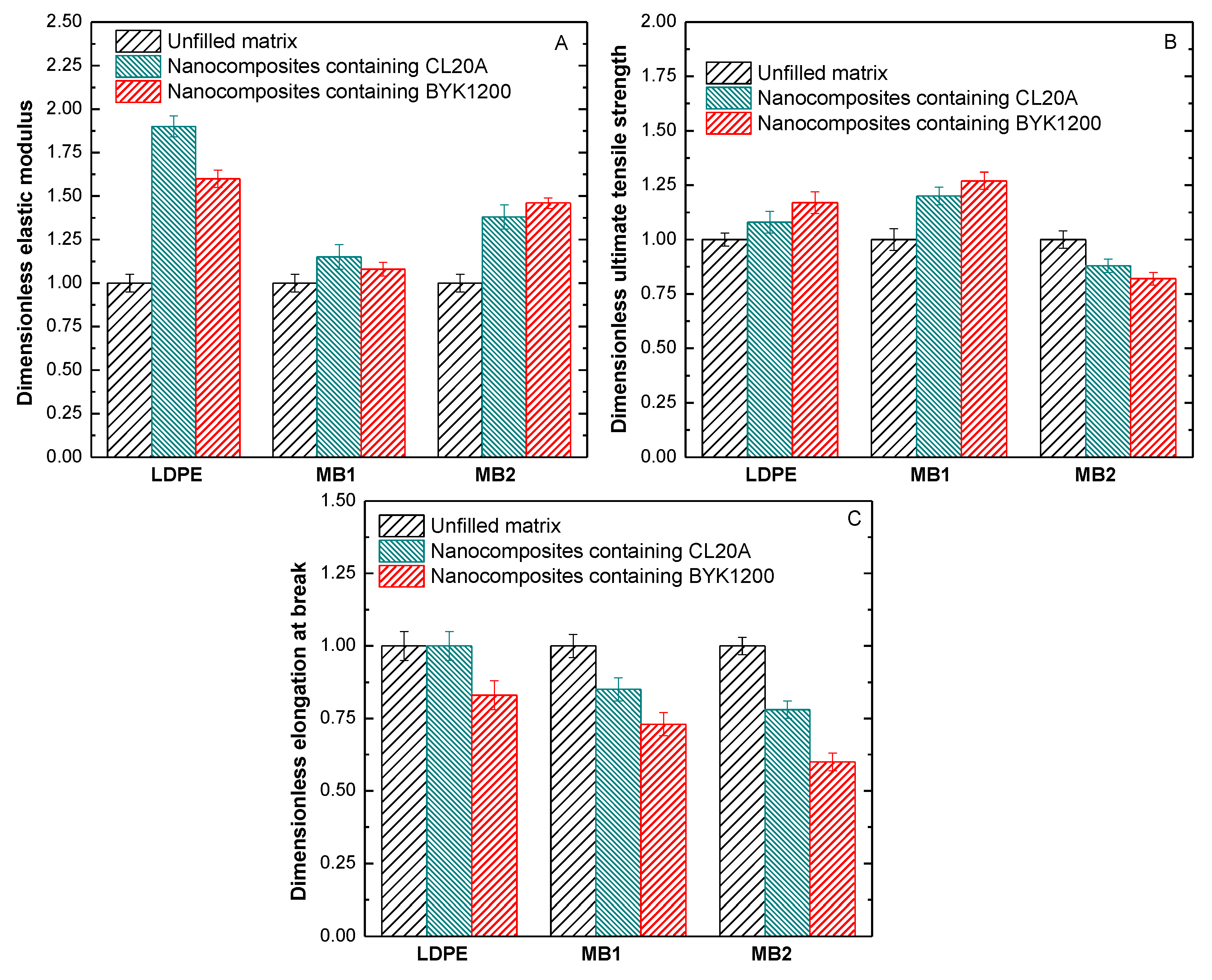
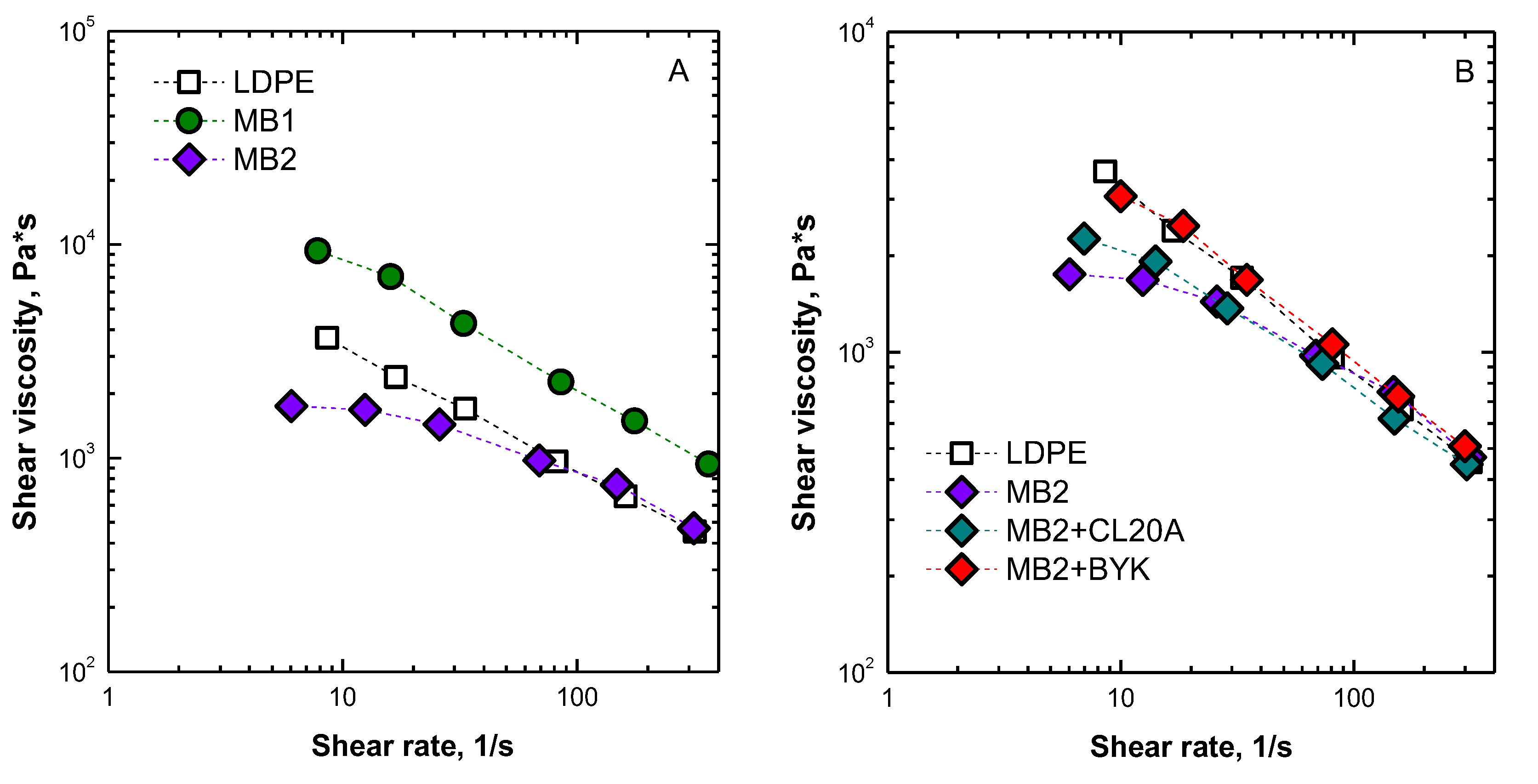
| Polymer Matrix | Temperature Profile (°C) | Screw Rotation Speed (rpm) |
|---|---|---|
| MB1 | 90-11 -130-140-140-150-150 | 205 |
| MB2 | 90-110-130-140-140-145 -145 | 220 |
| LDPE | 110-120-140-160-170-180-180 | 220 |
| Elastic Modulus (E) (Pa) | Ultimate Tensile Stress (UTS) (MPa) | Elongation at Break (EB) (%) | |
|---|---|---|---|
| LDPE | 80 ± 8.1 | 12.0 ± 3.2 | 613 ± 48 |
| LDPE + CL20A | 152 ± 19.1 | 12.9 ± 0.5 | 615 ± 47 |
| LDPE + BIK1200 | 128 ± 12 | 14.1 ± 3 | 512 ± 38 |
| MB1 | 111 ± 6.5 | 13.4 ± 3.4 | 475 ± 52 |
| MB1 + CL20A | 127 ± 8.4 | 16.1 ± 0.7 | 406 ± 50 |
| MB1 + BYK | 120 ± 9.0 | 16.9 ± 3.3 | 350 ± 20 |
| MB2 | 105 ± 14.2 | 17 ± 1.6 | 620 ± 10 |
| MB2 + CL20A | 145 ± 17.0 | 15.0 ± 1.5 | 487 ± 19 |
| MB2 + BYK | 153 ± 19.4 | 14.2 ± 0.8 | 378 ± 15 |
| MD | TD | |||||
|---|---|---|---|---|---|---|
| E (Pa) | UTS (MPa) | EB (%) | E (Pa) | UTS (MPa) | EB (%) | |
| LDPE | 170 ± 10.1 | 26 ± 1.8 | 350 ± 20 | 160 ± 12.1 | 27 ± 1.9 | 540 ± 14 |
| MB2 | 320 ± 7.2 | 31.5 ± 2.0 | 316 ± 20 | 275 ± 9.9 | 27.5 ± 1.8 | 467 ± 22 |
| MB2 + CL20A | 398 ± 7.0 | 34.5 ± 1.1 | 352 ± 18 | 390 ± 8.5 | 32.2 ± 1.7 | 402 ± 15 |
| MB2 + BYK | 452 ± 9.3 | 39.5 ± 0.6 | 420 ± 15 | 462 ± 10.1 | 31.5 ± 1.3 | 435 ± 25 |
Publisher’s Note: MDPI stays neutral with regard to jurisdictional claims in published maps and institutional affiliations. |
© 2021 by the authors. Licensee MDPI, Basel, Switzerland. This article is an open access article distributed under the terms and conditions of the Creative Commons Attribution (CC BY) license (https://creativecommons.org/licenses/by/4.0/).
Share and Cite
Mistretta, M.C.; Botta, L.; Arrigo, R.; Leto, F.; Malucelli, G.; La Mantia, F.P. Bionanocomposite Blown Films: Insights on the Rheological and Mechanical Behavior. Polymers 2021, 13, 1167. https://doi.org/10.3390/polym13071167
Mistretta MC, Botta L, Arrigo R, Leto F, Malucelli G, La Mantia FP. Bionanocomposite Blown Films: Insights on the Rheological and Mechanical Behavior. Polymers. 2021; 13(7):1167. https://doi.org/10.3390/polym13071167
Chicago/Turabian StyleMistretta, Maria Chiara, Luigi Botta, Rossella Arrigo, Francesco Leto, Giulio Malucelli, and Francesco Paolo La Mantia. 2021. "Bionanocomposite Blown Films: Insights on the Rheological and Mechanical Behavior" Polymers 13, no. 7: 1167. https://doi.org/10.3390/polym13071167
APA StyleMistretta, M. C., Botta, L., Arrigo, R., Leto, F., Malucelli, G., & La Mantia, F. P. (2021). Bionanocomposite Blown Films: Insights on the Rheological and Mechanical Behavior. Polymers, 13(7), 1167. https://doi.org/10.3390/polym13071167










